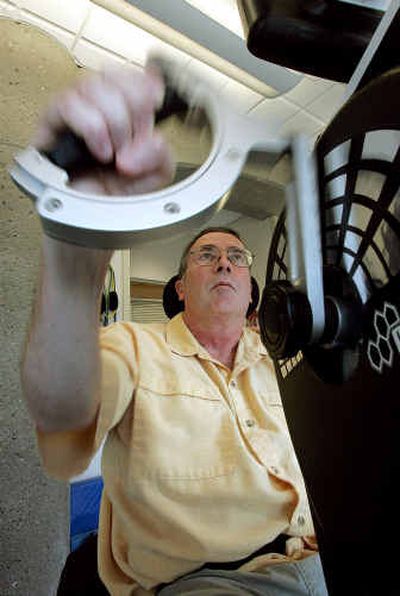ALS specialist facing dread end of disease

SAN FRANCISCO – The shocking self-diagnosis dawned slowly but inevitably on Dr. Richard Olney, a top neurologist who dedicated his career to helping those afflicted with the fatal “Lou Gehrig’s disease.”
Three surgeries to relieve a compressed disk in his back didn’t solve the weakness that started in his right knee and spread to both legs. When his arms started to fail, he knew he was in the grips of a neurological disorder. Then his worst fears were realized: He had amyotrophic lateral sclerosis, or ALS.
“I expected to live into my 80s like my parents did,” said Olney, struggling to get his words out through an amplifier resting on his lap in his motorized wheelchair at the University of California, San Francisco. “But I’ve done more in my 56 years than most people have done in their whole life. I can’t complain too much.”
Olney resigned last year as head of the university’s renowned ALS center, which he’d founded in 1993, turning it over to his protégé, Dr. Cathy Lomen-Hoerth. But he’s not giving up his struggle against the disease, which mystifies experts today as much as it did when New York Yankees slugger Lou Gehrig died of it in 1941.
He’s signed on as the first human guinea pig in a trial of two drugs that slowed the disease’s progress in mice, and he’s also using the time he has left to raise awareness and money to combat ALS.
Olney was famous for spending countless hours counseling patients, and that spirit lives on at the ALS center, where Lomen-Hoerth said she tries to summon the same soothing words and advice as she attends to her own patients – who now include Olney.
UCSF has set up a fund in Olney’s name and he intends to continue his campaign – doing interviews and agreeing to stay in the public eye – until his strength gives out. Olney’s health has rapidly declined since he was diagnosed in June.
“He spent his life trying to make a difference in this disease,” his wife of 30 years, Paula, said as Olney slowly worked his legs in UCSF’s specialized gym. “If this is the way it has to be done … We’ll keep doing this until Rick no longer can. It’s what he wants to do.”
Some 30,000 Americans currently have ALS, a small number when compared to other brain diseases. But that’s because ALS typically kills quickly, often within a year or two after diagnosis. (Astrophysicist Stephen Hawking, who was diagnosed with the disease 40 years ago, is a notable exception.)
About 10,000 new cases are diagnosed every year. And while about 10 percent of the cases have genetic roots, it’s not known how the other 90 percent occur. The disease isn’t contagious, so Olney didn’t get it from one of his patients.
With ALS, only the brain cells that control muscles die. The intellect remains intact even as the disease immobilizes the victim’s body.
“That’s the internal horror for all of us working in ALS and who know Rick,” said Jeffrey Rothstein, a Johns Hopkins University ALS researcher who spoke at a December symposium held in Olney’s honor. “ALS and pancreatic cancer are probably the two worst diseases you can have.”
There’s no real treatment for ALS. The one drug approved by federal regulators extends life by a few months for some.
Rothstein is among a handful of researchers developing possible treatments using gene therapy. Later this year, he and his colleagues hope to test in humans a common virus they’ve engineered to carry a gene that produces a growth factor directly to the brain and spinal cord. This technique significantly extended the lives of ALS-afflicted mice. Rothstein and others also hope to turn stem cells into replacement brain cells.
The latest technologies seem promising, but breakthroughs will probably come too late for Olney. He knows this, and has made peace with it.
“In the last few months, I haven’t felt very sad,” he said.
Such bravery keeps everyone around him going, Olney’s wife says. Still, to say these past months have been terrible for the Olney family is to do insult to just how bad it has been.
Olney’s mother died last month. His mother-in-law succumbed to cancer under his roof last summer, while he was remodeling his home to add a wheelchair ramp and other equipment he would soon need.
More than anyone, Olney knew the kind of storm that was brewing. He even purchased a bed that moves his body every 15 minutes. Now, his wife — a nurse — doesn’t have to get up every hour to turn him over.
Still, other, smaller indignities have piled up for the Olneys as Richard, a former marathon runner, has became trapped inside an increasingly useless body. Even his decades of work helping others navigate the health care bureaucracy hasn’t saved him from insurance hassles, like the form letters badgering for doctor’s signatures and the date when he’ll return to work.
A cherished family painting Olney’s mother shipped right before she died was badly damaged in transit, pitting Paula Olney in a Catch-22 bureaucratic battle with the shipping company to make good.
“I’m so mad at God,” Paula says, spitting out a bitter laugh when asked if religion played any coping role. “How can he be so mean? This is such a royal shaft.”
She pauses for a second, gathers her composure. The one-task-at-a-time coping mechanism that helps them get through the day kicks back in.
She sighs:
“All I want to do is get the painting fixed before he dies.”